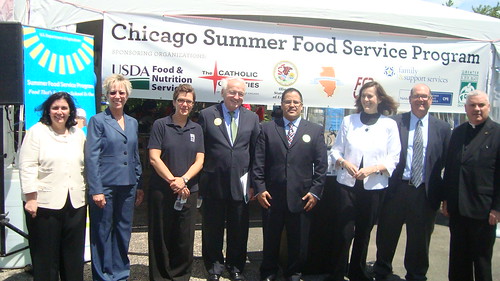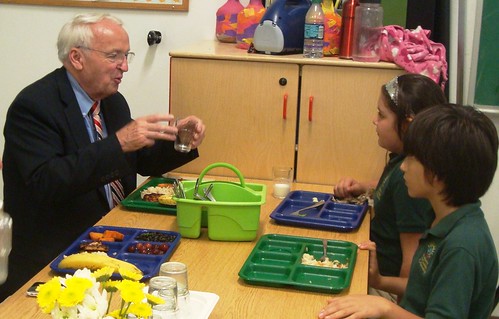
During my recent trip to Chicago, I had the great fortune to visit several places that were doing tremendous work with many of USDA’s nutrition programs. One of the first stops was to a local school where children were really excited to learn more about where their food comes from. “Know your farmer, know your food!” a first-grader from south Chicago’s Academy for Global Citizenship exclaimed during my whirlwind tour of the Windy City. The children at this Healthier US School Challenge (HUSSC) award-winning school, in fact, had an amazing knowledge about community-based food systems Academy for Global Citizenship takes USDA’s Farm to School effort to heart by using some locally sourced food for its school meals. In addition, the school shares the fresh, healthy produce and herbs its school garden yields with the families of students.
But these students weren’t the only ones learning about healthier eating habits and where their food comes from in Chicago. The largest high school garden I’ve ever visited was in the heart of one of Chicago’s neighborhoods. Operated by Chicago Botanic Garden’s Green Youth Farm, high schoolers spend the summer there growing, harvesting and cooking fruits and vegetables they then consume themselves and sell to the residents of local food desert communities through farmers markets. Students learn how to grow and appreciate healthy food and how to operate as businessmen and women. Some local restaurants are even using the garden’s tomatoes and lettuce and advertising the fact that they have locally sourced ingredients on their menus. It was apparent to me that the produce coming out of Dyett High School’s garden was in demand from nearly everyone—students, neighbors, restaurants and farmers’ markets!
Speaking of farmers’ markets, I also stopped by the Daley Plaza Farmers’ Market in downtown Chicago. Experimental Station, a local non-profit, has done some outstanding work in the past few years helping markets equip themselves to accept Supplemental Nutrition Assistance Program (SNAP) benefits electronically. This year the market had a record opening day with almost $1,000 of SNAP benefits used to purchase fresh fruits and vegetables. It is terrific to see SNAP benefits helping supplement the food budgets of low-income Americans in a healthy way and fueling the local economy at the same time.

Finally, I helped kickoff the city’s Summer Food Service Program (SFSP). During the school year, more than 21 million children receive free and reduced-price lunch through the National School Lunch Program. And yet, when school lets out, only slightly more than 3 million receive a meal through a summer program. USDA’s SFSP is designed to address that gap. Chicago’s SFSP is spearheaded by an ambitious group of dedicated partners, including the Chicago Public Schools, Catholic Charities, Illinois Hunger Coalition, Greater Chicago Food Depository, Chicago Archdiocese Nutrition Services, City of Chicago Department of Family and Support Services and the Illinois State Board of Education.
I was amazed to learn that the city already has over 1,000 sites operating—with more to come. And to do even better than the 18% increase in meals served last summer over the previous summer, the consortium of anti-hunger and feeding partners decided to target ten Chicago neighborhoods that were underserved. After visiting with the dedicated leadership and staff from these organizations, I have little doubt that even more meals will be served this summer. A summer with fewer hungry kids is a summer that leads to a stronger, healthier America—a country that can win the future.
Please follow USDA’s Food and Nutrition Service on Twitter at http://twitter.com/usdanutrition
